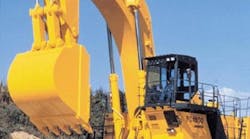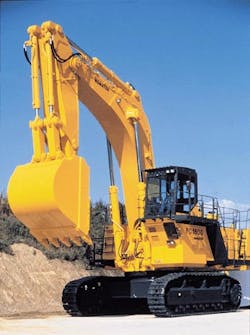To many people, the image of an excavator and a mining operation are nearly inseparable. Seeing the powerful arm of the excavator scoop up hunks of dirt the size of SUVs can turn even grown men and women into little more than gaping children, amazed by the size and power of these machines.
Komatsu Mining Systems, Inc., Vernon Hills, Ill., recently introduced its latest model of excavator, the PC1800-6 — a machine that is sure to turn a few heads. While bystanders certainly will be impressed by its sheer size, operators, too, stand to be impressed by its range of improvements, including higher horsepower, greater comfort, and larger bucket capacities.
The PC1800-6 features a 15.7-yd3 bucket, and incorporates two Komatsu Saa6D140E-2 engines with a combined output of 908 hp, as well as an advanced load-sensing hydraulic system. The result is high digging forces and fast cycle times.
Komatsu designed the PC1800-6 with operator comfort in mind. The operator's compartment is ergonomically designed to reduce fatigue and maintain high productivity. Operators are treated to a fully adjustable suspension seat and independently adjustable fingertip joystick controls, in addition to a climate control system with two independent air-conditioning units.
Hydraulics at work
Three working modes are used on the PC1800-6, enabling the operator to tailor the equipment's performance to the working conditions. A unique two-mode boom selector allows for choosing between smooth and power operations. Selecting the third mode, heavy-lift, provides a 7% additional boom lifting force for the most demanding lifting jobs.
Operation of the implements is accomplished primarily through two joysticks - the left controls the swing and stick (arm), and the right controls the boom and bucket. Flipping an on/off switch on the control panel engages the shockless boom control, which dampens the vibrating effect of the boom, through an inline check return valve. This feature has been shown to greatly reduce operator fatigue, as well as reduce spillage from the bucket.
The PC1800-6's hydraulic system features four of Komatsu's variable-displacement axial-piston hydraulic pumps for all implement and travel functions. Each has a maximum flow output of 111 gpm. The swing circuit is a totally independent circuit, using two Komatsu HPV 160 variable-displacement axial-piston pumps, with a maximum output of 83 gpm each.
Komatsu's Open Center Load Sensing System reduces hydraulic losses during operation and improves the machine's maneuverability by controlling the pumps' swashplate angle and matching the engine's performance to the pumps. The pump absorption torque can be set to DH, H, or G modes. These modes are defined as follows: DH mode (100%) is for heavy work, where large production is needed, along with maximum engine power. H mode (95%) is for normal digging and loading operations. G mode (83%) is for light-duty work, such as leveling and finishing operations.
The hydraulic system was specifically designed to deal with the brutal conditions found at most mining sites. Each main hydraulic pump diverts flow to its own dedicated high-pressure in-line filter. The hydraulic cylinders all incorporate metal guard rings to reduce contamination and contribute to a cleaner system.
The hydraulic oil return filters include a new hybrid element, developed by Komatsu, which increases the element replacement interval from 250 to 500 hr, and extends the hydraulic oil replacement interval from 2000 to 5000 hr. The element has a special construction, in which 25% of the circumference is constructed of a high-performance glass media, and the remainder is a dense paper gradient media. As a result, small particles are captured throughout the glass media, allowing greater life for the paper media.
To make troubleshooting easier, the excavators also feature Komatsu's Vital Health Signs Monitoring System (VHMS). VHMS monitors and logs the chassis condition, operating ability, faults, and any maintenance that has been performed. Data is stored in a controller, and can be downloaded to a PC. Within minutes, a service technician can access pressures, speeds, or temperatures. The system also gives the ability to read real-time hydraulic pressures without hooking up gages. In addition, VHMS notifies the operator when maintenance is due.
Better design
The PC1800-6 was so well-engineered that its hydraulic system runs 11% cooler than its predecessor, and one user described it as "so big, but you can control it as if it were a small excavator working on a tight jobsite." And perhaps that's a good measure of a well-engineered product - making the behemoths as easy to operate as the little guys.
Peter Robson is senior service engineer at Komatsu America Corp., Rolling Medows, Ill.
Load-sensing system means more advantages for operators
Mining Technologies International, Sudbury, Ont., utilizes load-sensing hydraulic systems on their trackless mining equipment, which includes a complete line of Load Haul Dump (LHD) vehicles and articulated haulage trucks. Although this can be a more expensive system than a conventional one, it results in major advantages for the operator.
A load-sensing hydraulic system is comprised of two major components that are designed to function together as a team - the pump and the control valve. As the term load sensing implies, the pump produces only the flow and pressure required to activate the load. This eliminates partial pump flow over a relief valve - as could occur in a conventional gear-pump system, if a control valve is throttled to control actuator speed.
With load-sensing systems, the pump remains on standby - maintaining only minimal pressure and minimal flow - until a valve connects the system to a load. In this way, the pump is allowed to idle until a load is introduced, while at the same time producing control oil within the circuits.
The control oil is required to actuate the pilot controls, and also to signal the pump when a load is demanded from it. This reduces wear and tear on the pump, attached hosing and components - plus, it reduces heat generation throughout the hydraulic circuit, improving hydraulic efficiency.
The fact that the pump is idling means that the diesel engine does not have to consume fuel just to maintain a high hydraulic pressure in a system that is not doing any work at that time. In addition, the horsepower that would be used for this purpose can be transferred to either the drive train, boom/bucket circuit, or attachments. This transfers into cost saving through reduced fuel consumption and machine efficiency.
Once a load is demanded, the pump adjusts output flow to match the valve opening selected and pressure to overcome the load plus the preset change in pressure across the valve spool. Instead of measuring the pressure drop across an orifice in the pump outlet port, a load-sensing hydraulic system measures pressure downstream of a directional control valve. Thus, a constant pressure drop is maintained across the valve spool. This results in constant flow for any given opening of the directional control valve, regardless of the workload downstream or the operating speed of the pump.
Advantages
There are a number of areas in which load-sensing hydraulic systems present advantages over gear-pump systems in these types of loaders. They include:
* reduced heat generation in the hydraulic fluid* enhanced controllability of steer, boom, and bucket functions, and
* higher engine horsepower available to the drive train when crowding the muck pile.
In addition, the system is easily adaptable to electronic/computer control of pump flows and pressures. In applications where engine horsepower is marginal, the system offers better utilization of available power. Another benefit is that hydraulic-fluid life is extended, due to lower fluid temperatures.
Safer machine operation can result through the use of a load sensing system in several ways:
* more precise control of actuator speed* reduced system pressure shocking of hose assemblies, resulting in fewer hose failures, and
* cooler oil temperatures and less radiated heat from components.
Narrow vein mining
MTI has recently introduced a new LHD unit for narrow vein mining operations that utilizes the load-sensing hydraulics system. This unit incorporates a Deutz BF4M-1012C engine, which produces 68 hp. The engine is coupled with a Clark 18000 series transmission and a Clark C-271 torque converter for the power train. The scoop has a load rating of 5954 lb, with a breakout force of 11,933 lb. This gives the 1.5-yd3 bucket and its components up to 3000 psi for tough conditions and greater reliability.
The hydraulic pump is rated at 2300 rpm, and flows 25.1 gpm at 2200 psig. Four double-acting cylinders with chrome plated piston rods are used - one for steering, one for dump, and two for hoist functions. The system also features a sectional closed-center valve with load-sensing capabilities, and pressure and return filters with 10-µm absolute rating.
MTI has determined that the load sensing reduces horsepower requirements by 18.8 hp. The average horsepower for a conventional gear pump is 29.5 hp, while the average horsepower for the load sensing piston pump is 10.7 hp - resulting in a decrease in fuel consumption.
The machine uses hydraulic power stick steering for bi-directional operation. The stick is center-articulated, with collet-type center pins and self-aligning ball bushings on the bottom; this allows a turning angle of 38° in each direction.
Kirk Farrell and Vern Evans of MTI provided details on the company's load sensing equipment.
Hollow-piston cylinders ideal for mining, other tough applications
Founded in 1919, Lingk + Sturzebecher, Stuhr, Germany, has many years of experience in hydraulic engineering. L+S combined this with its familiarity in carbon-fiber reinforced plastics (CFRP) to produce a line of ultra- lightweight hollow-piston hydraulic cylinders. These cylinders, with barrels constructed of CFRP, are often less than half the weight of similar standard-piston steel cylinders, and are have been used in a variety of extreme applications, from the aerospace industry in Europe to a mining operation in South Africa.
With a working pressure of 10,150 psi, the L+S cylinders are appreciably more compact and in many cases weigh only 35% as much as their steel counterparts. This enormous weight saving is achieved through the use of materials with exceptionally high specific strength and rigidity, combined with modern design, analysis, and manufacturing procedures.
An example of the benefits of lightweight cylinders in the mining industry was apparent when L+S applied this technology to a bucket-wheel excavator. They replaced a steel cylinderweighing 220 lb with a CFRP cylinder of half the weight; the excavator saw an efficiency increase of 20%, when matched with an appropriately sized bucket.
Another application for CFRP cylinders is in foundation engineering. One common example has a stroke of approximately 7.8 in., a maximum working pressure of 8700 psi, and produces an axial force of approximately 112 tons. Made from conventional materials, such a cylinder would weigh between 143 and 198 lb. This weight makes fitting the cylinder a heavy job for the assembly team, especially in difficult-to-reach positions. Lifting gear is usually required, along with several people.
The low weight of these cylinders makes the use of lifting gear for transporting or fitting these cylinders on site unnecessary, and the physical strain on the assembly team is drastically reduced. Tensioning tasks can be carried out in less time by a single person.
Another significant benefit is that their modular construction allows for tailor-made designs to match specific customer requirements. Axial force, stroke, and passage (the inner diameter of the hollow cylinder rod), as well as hydraulic and mechanical connections, can be simply and quickly modified, giving a cylinder that is optimized in weight and design to the customer's needs.
Engineers at L+S are presently developing hollow-piston cylinders compatible with fresh water as the hydraulic fluid. This will eliminate the danger of ground or water contamination caused by broken hoses or leaks in threaded joints.
For more information visit www.lingk-sturzebecher.de.


